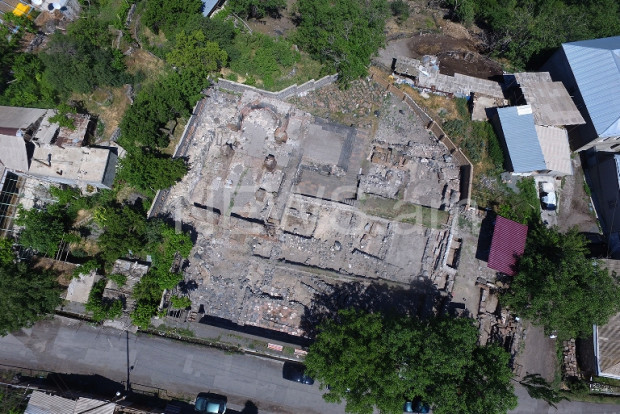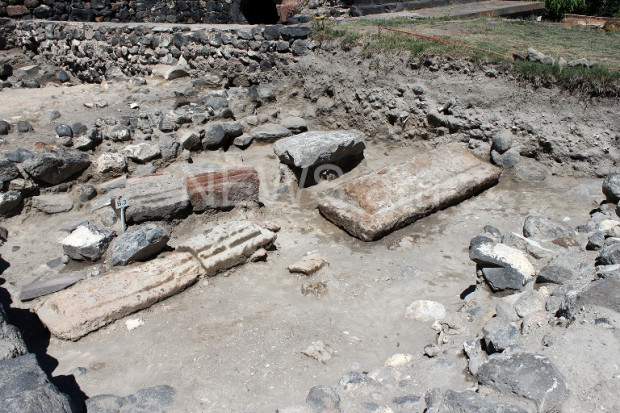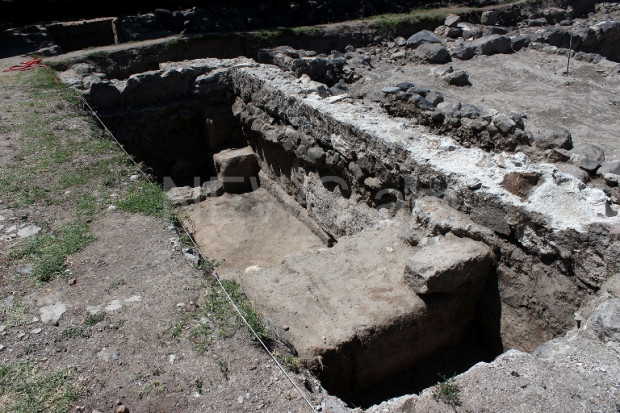The legend says: the Persian king Shapur II the Great (309-379 AD) did not manage to conquer Armenia after a series of invasions. His priests are advised to steal the remains of Armenian kingsso that the country lost its power, and the Persians could easily enslave it. Persian troops make a maneuver around Armenia, reach the source of the Euphrates River to approach the tomb of Ani Kamakh and steal the remains of Armenian Arsacid dynasty from the burial vault at the pagan temple of Aramazd god.
The Armenian army manages to smash the Persians to take away the king's remains. But in Christian Armenia, it is difficult to bury the ashes of pagan kings: the clergy oppose their burial in St. Vagharshapat (Etchmiadzin). According to the legend, a special crypt with carved sarcophagus and bas-reliefs depicting hunting scenes is being built in the village of Akhtsq on the slope of Mount Aragats. So, Akhtsq is believed to be the burial place of the Arsacid dynasty.
Excavations: The first excavations carried out in Akhtsq in the 19th century did not yield any results. No remains of the kings were found in the crypt. It seemed that King Shapur had achieved his goal: the remains of the great rulers of Armenia simply disappeared, and with them the country lost its greatness and glory as well as statehood.
Deputy Director of the Scientific and Cultural Center of Cultural and Historical Heritage, archaeologist Hakob Simonyan claims a new stage of excavation (photos) in 2015-2016 lifted the veil of this story, and the legend now has a “historical shape”. Three ossuary with remains were found under the floor of the church located next to the crypt. One of them has a cross indicating that these burials were made already during the Christian period.
What other facts except for the legend testify that the remains found in the ossuary could belong to the Armenian kings? As Hakob Simonyan says, firstly, all the bones are broken, and this may be the result of the fact that the Persians unearthed and carried them away in a hurry. Secondly, anthropological studies showed that bones belong to people of different sex and age, which indicates a family burial.
“If it were the relics of saints, it would be the bones of adult men, not children and women. That is, the Persians have stolen the remains of all the members of the royal families from the tomb,” he explains.
Thirdly, according to the archaeologist, some bones from ossuaries are charred, and we know that in the pre-Christian period the bodies of the kings were cremated.
According to Hakob Simonyan, the fact that the ossuaries were buried under the altar of the church also prove the fact. Masonry was dismantled, the boxes were put into the ground, then the masonry was reassembled. Why?
“It was a war time. Armenia was fighting against the great power of the Sasanian Empire – one of the most powerful countries in the world. Any moment the Persians again could make an attempt to take away the bones. That is, it was necessary to hide them in the most secure place,” the researcher says.
He added that the main crypt was either built in order to distract attention, or some of the remains were buried there. Although, this is still a hypothesis. For more accurate data, laboratory studies of the remains are needed, and this requires funding.
Hakob Simonyan shows us what they managed to find in Akhtsq during the excavations this year. Several Christian graves with inscriptions in Armenian, the remains of a palace complex, a paved alley with a cold stream descending from the top of Mount Aragats in the middle. All this shows that noble people used to live here in the early Middle Ages.
.JPG)




